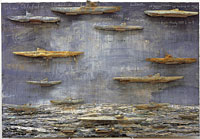To mark its tenth anniversary, the Guggenheim Museum Bilbao dedicates a major exhibition to Anselm Kiefer, offering over a hundred monumental works from the last ten years coming from the artist's personal holdings, as well as from private and public collections, including its own
A reflection on global civilization and the human condition
Kiefer, born in 1945, grew up witnessing the destruction of modern warfare, the partition of his homeland, and its struggle for renewal. Believing that there are no truths, but only interpretations, he constantly questions the place of humans in the cosmos. Infused with references to both the German romantic tradition and its political and philosophical heritage, his large-scale works combine a nearly monochromatic palette with unorthodox materials, such as lead, wire, straw, plaster, mud, seeds, sunflowers, ash, and dust. The result is a prolific oeuvre whose monumental scale and rich interplay of textures heighten the solemnity and transcendental nature of its contents. In recent years, Kiefer has explored a more universal set of themes, focusing on the global fate of art and culture, as well as spirituality and the workings and mysteries of the mind. His art reflects on global civilization and faith, and alerts us to the cyclical patterns of history, while exploring and struggling with the fundamental experiences and burdens of the human condition.
In strong relationship with architecture
This exhibition, organized thematically, documents with particular emphasis Kiefer's monumental interventions, works that have a strong relationship with architecture. The museumks that have a strong relationship with architecture. The museum Atrium introduces a new site-specific installation, created for this space, a colossal desolate winter landscape 15 meters high, whose dizzying verticality corresponds with Gehry's spectacular atrium. The presentation is divided into an enfilade of single chapters, dedicated to discrete but interrelated bodies of works, memories, and ideas illustrating the artist's research, offering a visual and emotional impact typical of Kiefer's. His references are historically, culturally, and geographically diverse. He engages with specific moments in history to address universal themes and concerns that begin to overlap and bleed into one another. The exhibition highlights Kiefer's diverse literary and poetic inspirations, His paintings become interwoven with architecture in order to confront issues of nature, science, religion, and history. With For Khlebnikov (2004), a series of paintings dedicated to the Russian Futurist poet Velimir Khlebnikov (1855-1922). Kiefer relates to Khlebnikov's idea that cataclysmic sea battles happen every 317 years. The theme of combined religions is examined in Chevirat Ha-Kelim, a poignant ensemble of monumental arched works, created originally for the altarpieces of the chapel of the La Salpêtrière hospital in Paris.
Memory preserved
Kiefer examines two different historical periods through bodies of work emphasizing the female identity and experience. The Women of the Revolution (1992), a series inspired by Jules Michelet's (1798-1874) book of the same title, and comprised of lead beds with photographs and writings scrawled on the wall, evokes major feminine personalities of the French Revolution. In Women of Antiquity (2000-2004), headless mannequins in white crinoline dresses represent mythological and historical figures from antiquity. Some of these women are heroines, and some villains, but all are remarkable for their strength and determination. Kiefer's meditations on nature and science continue in The Secret Life of Plants, a frieze of 28 paintings comprising branches, lead, and wire. Pursuing his life-long concern with books, For Paul Celan (2006) is made of massive and defiant lead books pierced by flowers, ancient symbols of both fertility and the transience of life, which pay tribute to the Jewish Romanian poet and essayist Celan, who miraculously survived the Holocaust, and with whom Kiefer shares many of the same themes and concerns: a sense of mourning and melancholy, and the importance of preserving memory as a means of coming to terms with the traumas of human history.
Illustration: ANSELM KIEFER Velimir Khlebnikov Fate of the People (Velimir Khlebnikov Schicksale der Völker), 2004. Mixed media, 380 x 560 cm Courtesy of the David Roberts Collection
PUBLICATION
Exhibition catalogue Edired by Germano Celant, texts and interviews by Anselm Keffer, 30x30 cm, 600 p., fully illustrated BW and col., Éditions Skira 55€
To see more illustrations, click on VERSION FRANCAISE at the top of this page
|









